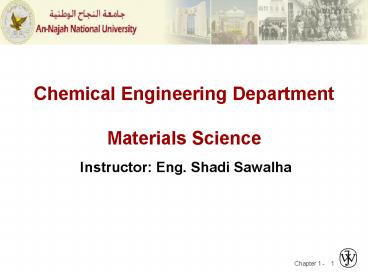Chemical Engineering Department Materials Science - PowerPoint PPT Presentation
1 / 16
Title:
Chemical Engineering Department Materials Science
Description:
Materials Science Instructor: Eng. Shadi Sawalha * * Chapter 1 - Introduction What is materials science? Why should we know about it? Materials drive our society ... – PowerPoint PPT presentation
Number of Views:29
Avg rating:3.0/5.0
Title: Chemical Engineering Department Materials Science
1
Chemical Engineering DepartmentMaterials Science
- Instructor Eng. Shadi Sawalha
2
Chapter 1 - Introduction
- What is materials science?
- Why should we know about it?
- Materials drive our society
- Stone Age
- Bronze Age
- Iron Age
- Now?
- Silicon Age?
- Polymer Age?
3
Example Hip Implant
- With age or certain illnesses joints deteriorate.
Particularly those with large loads (such as
hip).
Adapted from Fig. 22.25, Callister 7e.
4
Example Hip Implant
- Requirements
- mechanical strength (many cycles)
- good lubricity
- biocompatibility
Adapted from Fig. 22.24, Callister 7e.
5
Example Hip Implant
Adapted from Fig. 22.26, Callister 7e.
6
Hip Implant
- Key problems to overcome
- fixation agent to hold acetabular cup
- cup lubrication material
- femoral stem fixing agent (glue)
- must avoid any debris in cup
Ball
Acetabular Cup and Liner
Femoral Stem
Adapted from chapter-opening photograph, Chapter
22, Callister 7e.
7
Example Develop New Types of Polymers
- Commodity plastics large volume ca. 0.50 /
lb Ex. Polyethylene Polypropylene Polystyrene
etc. - Engineering Resins small volume gt 1.00 /
lb Ex. Polycarbonate Nylon Polysulfone etc.
Can polypropylene be upgraded to properties
(and price) near those of engineering resins?
8
Structure, Processing, Properties
Properties depend on structure
ex hardness vs structure of steel
6
00
5
00
Data obtained from Figs. 10.30(a) and 10.32 with
4 wt C composition, and from Fig. 11.14 and
associated discussion, Callister 7e. Micrographs
adapted from (a) Fig. 10.19 (b) Fig. 9.30(c)
Fig. 10.33 and (d) Fig. 10.21, Callister 7e.
4
00
Hardness (BHN)
3
00
2
00
100
0.01
0.1
1
10
100
1000
Cooling Rate (ºC/s)
Processing can change structure
ex structure vs cooling rate of steel
9
Types of Materials
- Metals
- Strong, ductile
- high thermal electrical conductivity
- opaque, reflective.
- Polymers/plastics Covalent bonding ? sharing of
es - Soft, ductile, low strength, low density
- thermal electrical insulators
- Optically translucent or transparent.
- Ceramics ionic bonding (refractory) compounds
of metallic non-metallic elements (oxides,
carbides, nitrides, sulfides) - Brittle, glassy, elastic
- non-conducting (insulators)
10
The Materials Selection Process
1.
Pick Application
Determine required Properties
Properties mechanical, electrical,
thermal, magnetic, optical, deteriorative.
2.
Properties
Identify candidate Material(s)
Material structure, composition.
3.
Material
Identify required Processing
Processing changes structure and overall
shape ex casting, sintering, vapor deposition,
doping forming, joining, annealing.
11
ELECTRICAL
Electrical Resistivity of Copper
Adapted from Fig. 18.8, Callister 7e. (Fig. 18.8
adapted from J.O. Linde, Ann Physik 5, 219
(1932) and C.A. Wert and R.M. Thomson, Physics
of Solids, 2nd edition, McGraw-Hill Company, New
York, 1970.)
Adding impurity atoms to Cu increases
resistivity.
Deforming Cu increases resistivity.
12
THERMAL
Space Shuttle Tiles --Silica fiber
insulation offers low heat conduction.
Thermal Conductivity of Copper --It
decreases when you add zinc!
Adapted from chapter-opening photograph, Chapter
19, Callister 7e. (Courtesy of Lockheed Missiles
and Space Company, Inc.)
Adapted from Fig. 19.4W, Callister 6e. (Courtesy
of Lockheed Aerospace Ceramics Systems,
Sunnyvale, CA) (Note "W" denotes fig. is on
CD-ROM.)
Adapted from Fig. 19.4, Callister 7e. (Fig. 19.4
is adapted from Metals Handbook Properties and
Selection Nonferrous alloys and Pure Metals,
Vol. 2, 9th ed., H. Baker, (Managing Editor),
American Society for Metals, 1979, p. 315.)
13
MAGNETIC
Magnetic Permeability vs. Composition
--Adding 3 atomic Si makes Fe a
better recording medium!
Magnetic Storage --Recording medium
is magnetized by recording head.
- Adapted from C.R. Barrett, W.D. Nix, and
- A.S. Tetelman, The Principles of
- Engineering Materials, Fig. 1-7(a), p. 9,
- Electronically reproduced
- by permission of Pearson Education, Inc.,
- Upper Saddle River, New Jersey.
Fig. 20.23, Callister 7e. (Fig. 20.23 is from
J.U. Lemke, MRS Bulletin, Vol. XV, No. 3, p. 31,
1990.)
14
OPTICAL
Transmittance --Aluminum oxide may be
transparent, translucent, or opaque
depending on the material structure.
Adapted from Fig. 1.2, Callister 7e. (Specimen
preparation, P.A. Lessing photo by S. Tanner.)
15
DETERIORATIVE
Stress Saltwater... --causes cracks!
Heat treatment slows crack speed in salt
water!
Adapted from Fig. 11.20(b), R.W. Hertzberg,
"Deformation and Fracture Mechanics of
Engineering Materials" (4th ed.), p. 505, John
Wiley and Sons, 1996. (Original source Markus
O. Speidel, Brown Boveri Co.)
Adapted from chapter-opening photograph, Chapter
17, Callister 7e. (from Marine Corrosion, Causes,
and Prevention, John Wiley and Sons, Inc., 1975.)
16
SUMMARY
Course Goals
Use the right material for the job.
Understand the relation between properties,
structure, and processing.
Recognize new design opportunities offered
by materials selection.































